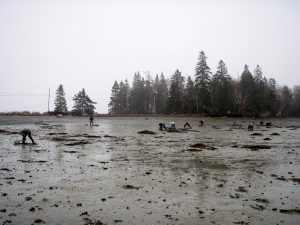Reducing Unnecessary Closures in Maine’s Shellfish Growing Areas
 Institution: University of Maine
Institution: University of Maine
Sponsor: Maine Water Resources Research Institute (2020)
Data-driven support for adaptive pollution-based closure decisions in shellfish growing areas of Maine
There are major public health issues associated with fecal-borne pathogens entering shellfish growing areas (SGAs) across the Maine coast. Storm runoff can mobilize pathogens from sources such as leaking septic systems, combined sewer overflows, and overboard discharge sites into coastal waters. The Maine Department of Marine Resources’ Bureau of Public Health (DMR) oversees the application of the National Shellfish Sanitation Program and has established statewide harvest closure rules based on observed links between heavy rainstorms and coastal pollution. This statewide rule takes a precautionary approach to prevent harvesting of storm-polluted shellfish based on daily rainfall exceeding two inches, or one inch in particularly sensitive locations.
However, this approach can produce unnecessary closures in locations where pollution problems have not occurred. Storm patterns may not predictably trigger regional or statewide pollution because the intensity of rainfall, storm runoff, pollution sources, and tidal mixing exhibit substantial spatial variability across Maine (even at very local scales), and there are many other human and environmental factors that can influence pollution trends. Wild and aquaculture shellfish harvests recently accounted for approximately $56 million for Maine’s coastal economy, thousands of local jobs, and a cherished way of life. Storm-related pollution poses significant and poorly anticipated threats to public health with real economic and cultural consequences. DMR seeks to reduce unnecessary closures and promote greater economic potential while remaining compliant with national sanitation standards.
The research team is building a comprehensive collaboration with DMR and commercial partners, including Hollander & de Köning mussel aquaculture and Waukeag Neck Oyster Company, to analyze the storm-pollution link, expand the analysis to include more potential pollution factors, and provide improved, location-specific decision support for pollution-based harvest regulation. The intent of this collaboration is to reduce unnecessary closures and allow for earlier safe re-openings following closures with no added risk to public health. The team’s approach integrates stakeholder engagement, spatial data analytics, and workforce development for students. Decision support will be based on observed linkages between coastal water quality (measured as fecal coliform scores), and human (septic systems, overboard discharge sites, combined sewer overflows, wastewater treatment plant outfalls) and environmental (precipitation, runoff, tides, temperature, salinity, season) factors governing SGA pollution source, delivery, and residence time.
Team Leader:
- Sam Roy, Research Assistant Professor, Mitchell Center and School of Earth and Climate Sciences, UMaine
Team Members:
- Sean Smith, Associate Professor, School of Earth and Climate Sciences and Mitchell Center, UMaine
- Bridie McGreavy, Assistant Professor, Dept. of Communication and Journalism and Mitchell Center faculty fellow, UMaine
Partners:
